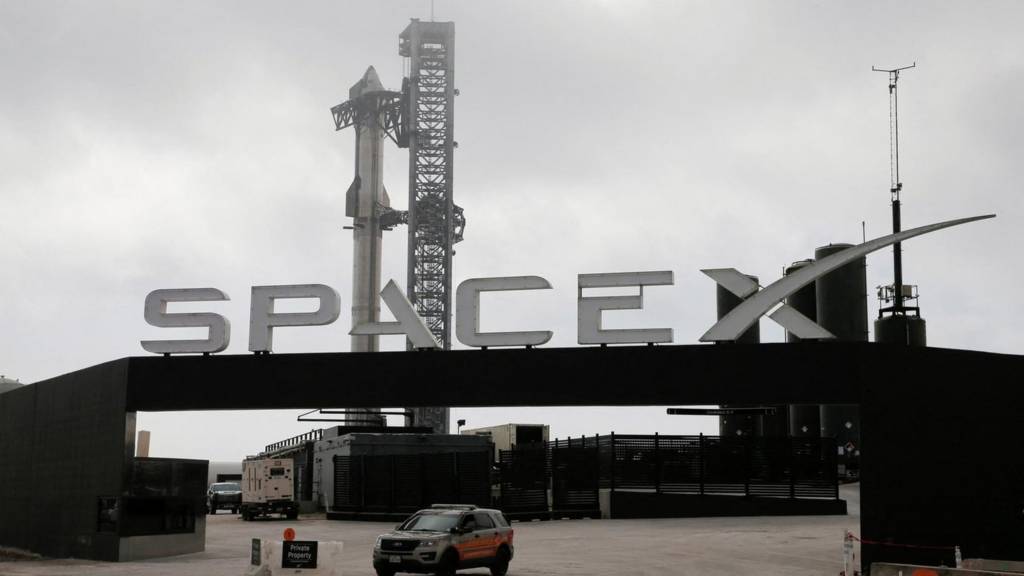ARTICLE AD BOX

12,883
viewing this page
Got a TV Licence?
You need one to watch live TV on any channel or device, and BBC programmes on iPlayer. It’s the law.
Live Reporting
Edited by Aoife Walsh
All times stated are UK
Starship essential to Musk’s short and long-term goals - especially Mars

Jonathan Amos
Science correspondent

Copyright: EPA
For SpaceX founder Elon Musk, the plans for his next-generation Starship are both near and far-term.
In the near-term, he needs its lifting potential to service his Starlink internet constellation. Already comprising over 5,500 spacecraft, this system requires the ongoing addition and replacement of satellites.
And Starship will be responsible for the heft of it.
Down the road, Musk has talked about sending people to Mars - of making humans "a multi-planetary species".
Unsurprisingly, Starship is integral to making that dream a reality.
How big is Starship?
Starship is the most powerful rocket system ever to lift off Earth.
The 33 engines at the base of the Super Heavy booster produce 74 meganewtons of thrust. This dwarfs all previous vehicles, including those that sent men to the Moon in the 1960s-70s.

Copyright: .
SpaceX team begin loading propellant
We're now hearing from SpaceX that the team have started loading the propellant and launch is scheduled for 13:25 GMT (08:25 local time in Texas).
"The Starship team is go for prop load but keeping an eye on winds," SpaceX says.
Stay with us as we bring you the latest.
What happened during the last two flights?

Jonathan Amos
Science correspondent

Copyright: Reuters
You can be forgiven for not remembering exactly what happened in the last two test flights - the first one happened nearly a year ago.
During the maiden launch last April, we saw Starship end its mission close to where it started, just off the coast of Texas. The rocket lifted off but failed to separate and eventually tore itself apart four minutes after leaving the ground.
The second flight in November fared much better. It witnessed a clean getaway from the launch mount and a very adept separation of the two stages at the appropriate time.
However, the booster then blew up as it tried to push back closer towards the Texas coastline, and although the Starship carried on for several minutes, it eventually fell victim to a fire in its engine compartment and was terminated with explosive charges.
Elon Musk says numerous changes and upgrades have been made for what's being called the Integrated Flight Test 3, or IFT3.
What time will Starship launch?
In its latest update, SpaceX says it's hoping to launch Starship at 13:25 GMT (08:25 local time) from its base in southeast Texas - but that time could change.
Starship was originally expected to launch at 12:00 GMT, but the timing has been delayed a couple of times since.
The company said this was to allow more time for its team to clear "a few boats from the keep out area in the Gulf of Mexico".
What’s the plan for today’s launch?

Jonathan Amos
Science correspondent

Copyright: Reuters
Assuming everything goes as planned, Starship will rise up and head down range across the Gulf of Mexico in the direction of the Atlantic and Africa.
Stage separation - when the booster has done its job and comes apart from the Ship - is timed to occur at about two minutes and 44 seconds into the flight. It's a key moment in the mission. The Ship actually starts up its engines just before separation to maintain momentum and push on towards space.
SpaceX wants the Super Heavy booster to try to fly back to near the coast of Texas and come down vertically, to hover just above the Gulf's waters. It will then be allowed to topple over and sink.
The Ship is expected to power on until eight minutes and 35 seconds after lift-off, at which point it will shut down its engines and coast. If it makes it this far, the Ship will be perhaps 150km (93 miles) above the Earth and moving at more than 20,000km/h (12,400mph).
What is the Super Heavy Booster?

Jonathan Amos
Science correspondent
The space vehicle comes in two halves. The bottom segment - the Super Heavy booster - does the job of getting everything off the ground. At its base are 33 engines, burning a mix of liquid methane and liquid oxygen.
Engineers refer to the combination as methalox.
Firing in unison, the cluster of engines should produce in excess of 70 meganewtons of thrust. To put that in context, Nasa's biggest rocket - the Space Launch System, or SLS - produces 39 meganewtons off the pad, and that's over 20% more than the old space shuttle system could generate.
Starship is by far the most powerful launch system we've ever seen.
What does the top half - the ‘Ship’ - do?

Jonathan Amos
Science correspondent

Copyright: Reuters
The top half of Starship is called simply... the Ship. It's got six engines at its base, again burning methalox.
It's the business end of the system in the sense that it's inside the Ship that satellites would be stowed or a crew would sit.
Elon Musk says Starship should be able to put 150 tonnes of payload in a low-Earth orbit just a few hundred kilometres up.
Workhorse rockets today can do no more than about 20 tonnes to a similar altitude, and those vehicles are in part, or wholly, expendable: you need a new vehicle, or elements of a new vehicle, every time you launch.
Starship: An ambitious and next-generation reusable rocket

Jonathan Amos
Science correspondent
The 120m-tall (393ft) Starship is attempting to usher in a revolution in space transportation. The vehicle is being designed to be fully reusable.
All elements are intended to land propulsively back on Earth after use, be re-fuelled and then flown again. This is a hugely challenging endeavour and will take time to achieve (especially the landings).
But if Starship can be made to work, it will change the way we access space and radically lower the cost of putting people and things in orbit.
The most powerful rocket ever built aims for the stars … again

Hello and thank you for joining us at the BBC's mission control in London - more than 5,000 miles (8,000km) away from where Elon Musk's Starship rocket is set to make its third attempt at launching into the skies.
SpaceX has indicated ahead of this morning's launch that this will be the company’s most ambitious undertaking, as it strives to get the mammoth rocket, which measures 400 ft (122m) when combined with the Super Heavy booster, into lift-off.
It will be the rocket's third test flight, following attempts in April and November last year.
You'll be guided through the launch by our team here in London, alongside our science correspondent, Jonathan Amos. You can also watch the launch live by pressing the 'Play' button at the top of this page.

 1 year ago
30
1 year ago
30













 English (US) ·
English (US) ·